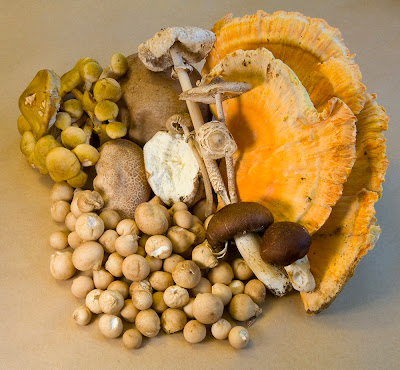We have started our education on mushrooms. It is difficult to find someone to teach us, so we sign up for all foraging tours with our local educators, Wildman Steve Brill and Russ Cohen. We have purchased several books on mushrooms. We hike the woods and find mushrooms, bring them home, and use some techniques we have learned to try to identify them. Robert takes many photos of the tops, bottoms, stalks, and bases, cuts them open to test for bruising and color changes, and spore prints them. We then get help from David Fischer's website to verify the mushrooms. Rarely, we eat them.

 A good mushroom we are comfortable with is the sulfur shelf (Laetiporus sulphureus), or chicken mushroom. We were very fortunate to find a very young specimen in September that yielded about 40 pounds of usable mushroom. The flesh has a very firm texture like chicken. We ate it fresh in many dishes, dehydrated some, and froze some more to use later.
A good mushroom we are comfortable with is the sulfur shelf (Laetiporus sulphureus), or chicken mushroom. We were very fortunate to find a very young specimen in September that yielded about 40 pounds of usable mushroom. The flesh has a very firm texture like chicken. We ate it fresh in many dishes, dehydrated some, and froze some more to use later.
We have also come across many honey mushrooms (Armillaria mellea), including a colony in our own back yard. These are good in soups, as they get a bit slimy when sautéed.
 Pear shaped puffballs (Lycoperdon pyriforme) are also another good one for us to search for. They can be very small, but are usually found in great quantities on a dead log. They cook up nicely, holding their shape and texture. We have also come across some giant puffballs (Langermannia gigantea) that fry up like a filet.
Pear shaped puffballs (Lycoperdon pyriforme) are also another good one for us to search for. They can be very small, but are usually found in great quantities on a dead log. They cook up nicely, holding their shape and texture. We have also come across some giant puffballs (Langermannia gigantea) that fry up like a filet.







